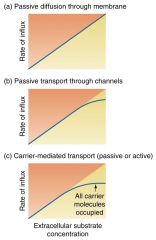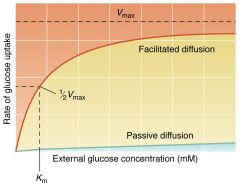![]()
![]()
![]()
Use LEFT and RIGHT arrow keys to navigate between flashcards;
Use UP and DOWN arrow keys to flip the card;
H to show hint;
A reads text to speech;
37 Cards in this Set
- Front
- Back
|
List the two types of membrane transport.
|
1) Passive transport
2) Active transport |
|
|
List the two types of passive transport.
|
Two types of passive transport:
1) Simple diffusion 2) Passive transport (aka "facilitated diffusion") |
|
|
List the two types of active transport.
|
Two types of active transport:
1) Primary active transport 2) Secondary active transport |
|
|
What kind of transport is simple diffusion?
|
Simple diffusion = passive transport
|
|
|
What kind of transport is facilitated diffusion?
|
Facilitated transport = passive transport
|
|
|
What is another name for facilitated diffusion?
|
Facilitated transport aka passive transport
|
|
|
What happens in simple diffusion?
|
Macro: Solute moves toward equilibrium without any inputted energy.
|
|
|
What does simple diffusion need in order to occur?
|
1) Concentration gradient
2) Solute encounters the plasma membrane 3) Solute can pass through the plasma membrane |
|
|
True or false?
A higher concentration gradient ='s greater movement of solutes. |
True.
A higher concentration gradient ='s greater movement of solutes. |
|
|
What doesn't simple diffusion need?
|
Simple diffusion doesn't need transmembrane proteins/channels.
|
|
|
Solutes can cross the membrane by simple diffusion if and only iff...
Give examples of what molecules can cross the cellular membrane via simple diffusion. |
1) Solute's H-bonds can be broken
2) Solute is lipid soluble Examples of molecules that can undergo simple diffusion across a cellular membrane: * Single -OH alcohols (e.g. methanol. ethanol) * Steroid hormones (e.g. estrogen, progesterone, testosterone, cortisol) |
|
|
Rate of diffusion (J) formula:
J = dQs/dT --> D(C1 - C2)/x What does each symbol mean? D, C1, C2, X |
D = diffusion coefficient
C1 = Higher concentration C2 = Lower concentration X = Distance between C1 and C2 |
|
|
What is the unit for the rate of diffusion (J)?
|
Unit for rate of diffusion:
Joules = moles/(cm^2*s) |
|
|
Rate of diffusion (J) formula:
J = dQs/dT --> P(C1 - C2) What is P? |
P = permeability constant = D/X
* D = Diffusion coefficient * X = Distance between C1 and C2 |
|
|
Diffusion is dependent upon which 5 characteristics?
|
Diffusion is dependent upon:
- Molecular weight - Size - Polarity - Solubility - Molecular shape |
|
|
What is the best predictor of diffusion?
What is it related to? |
The best predictor of diffusion is the partition coefficient, K.
The partition coefficient, K, is proportional to P (the permeability constant). |
|
|
How do hydroxyl groups help diffusion?
*Note: There are two. |
Hydroxyl groups help diffusion by:
- Facilitating H-bonding to water - Decreases lipid solubility |
|
|
Determine if each of the characteristics below are increased or decreased for molecules with: (a) more -OH substituents, and (b) less -OH substituents.
1) Hydrogen-bonding capacity 2) Water solubility 3) Lipid solubility |

|
|
|
What does facilitated diffusion need in order to occur?
*Note: There are two things. |
Facilitated diffusion needs:
1) Electrochemical gradient 2) Specialized membrane proteins |
|
|
What are the two types of specialized membrane proteins needed by facilitated diffusion?
|
- Channels and pores
- Carrier proteins |
|
|
What is the difference between how a solute enters a cell through: (1) channels and pores, and (2) carrier proteins.
|
1) Channels and pores: Solutes diffuse down its electrochemical gradient.
2) Carrier proteins: There is a conformational change with binding of the transported molecules. |
|
|
List the three types of facilitated transport.
|
Three types of facilitated transport:
1) Uniporter 2) Symporter 3) Antiporter |
|
|
List the two types of co-transport.
|
Two types of co-transport:
1) Symporter 2) Antiporter |
|
|
Draw a graph of the rate of influx for each of the following:
1) Passive diffusion through a membrane 2) Passive transport through channels 3) Carrier-mediated transport (passive or active) |

|
|
|
What is passive diffusion (through membranes) important for? Give examples of each.
|
Passive diffusion through membranes is important for:
- Small compounds (e.g. O2, CO2) - Lipid soluble compounds (e.g. ethanol, cortisol, testosterone, progesterone, estrogen) |
|
|
What is passive transport through channels important for?
|
Passive transport through channels is important for:
- Ions |
|
|
What is carrier-mediated transport (either passive or active) important for?
|
Carrier-mediated transport (either passive or active) is important for:
- Ions - Larger compounds - Water soluble compounds |
|

|
The rate of diffusion has a similar curve to that of enzymes.
|
|
|
List the four types of ion channels.
|
Four types of ion channels:
1) Voltage-gated 2) Phosphorylation-gated 3) Stretch-gated / tension-gated 4) Ligand-gated |
|
|
Draw diagrams of each of the four types of ion channels.
|

|
|
|
What does the Nernst equation describe?
|
The equilibrium potential; the potential for and degree by which the atom will diffuse.
|
|
|
What two forces act on ions within a cell?
|
Two forces that act on ions within a cell:
1) Chemical gradients 2) Electrical gradients The sum of these two things make up a cell's electrochemical gradient. |
|
|
Describe the Donnan equilibrium.
|
...
|
|
|
Describe the relative abundance of each ion in the internal and external cellular environments.
1) K+ 2) Na+ 3) Ca+2 4) Cl- |
1) [K+] cytosol > [K+] extracellular fluid
2) [Na+] cytosol < [Na+] extracellular fluid 3) [Ca+] cytosol < [Ca+2] extracellular fluid 4) [Cl-] cytosol < [Cl-] extracellular fluid |
|
|
List the two types of active transport.
|
Types of active transport:
1) Primary active transport 2) Secondary active transport |
|
|
Define each type of active transport.
|
1) Primary active transport
Is ATP dependent because substance will be transported against its electrochemical gradient. 2) Secondary active transport Ion moving with its electrochemical gradient provides the energy needed to move another substance against its electrochemical gradient. |
|
|
Name what substances primarily use each type of transport. Provide examples of each types of transport in detail.
|
---
|

